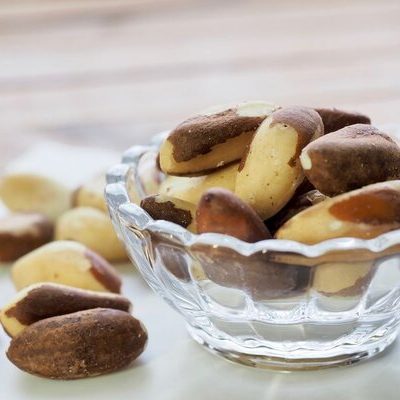
Brazil Nut
also known as Pará Nut
What is a Brazil nut?
The Brazil nut (Bertholletia excelsa) is a brown, oval-shaped nut that belongs to the monkey pot tree (Lecythidaceae) family. Contrary to popular belief, it is not actually a nut but a seed of the cannonball tree. This tree grows large monkey pots, which look like cannonballs, that hold various Brazil nuts inside.
The top 8 most popular brands of Brazil nut are:
- I’m A Nut
- Nut Cravings
- Terrasoul Superfoods
- We Got Nuts
- Happy Andes
- Jaybee’s
- Daily Nuts & Fruits
- Oh! Nuts
Origin of brazil nuts
This nut is native to South America and has been eaten by locals since at least 11,000 years ago. However, the first written account of this food was in 1569, when Spanish and Portuguese explorers were traveling through South America. The food itself earned its name from its country of origin and maintains it to this day. Brazil nuts wouldn’t reach North American until the 1800s and would take a while to become popular with locals. These days, around half of Bolivia’s exports of these nuts go directly to the United States.
Nutrition
A 100g serving of Brazil nuts contains:

Brazil nuts are nutrient-dense and offer various health benefits. This food is rich in selenium, which is essential to the proper functioning of the thyroid and can also influence cell growth and the immune system. In addition, this nut contains antioxidants, which have been linked to reducing inflammation and cellular damage. Moreover, studies show that Brazil nuts can help reduce bad cholesterol and improve heart health. Nonetheless, there are some risks associated with overconsumption of foods high in selenium, including breathing problems, heart attack, kidney failure. Therefore, it’s recommendable to limit your daily intake of this food.
Commercial production
This nut is found in Venezuela, Colombia, Ecuador, Peru, and Para in Brazil. It is mainly cultivated in mass quantities in the Amazonian forest of Brazil and planted annually on deep, well-drained medium to heavy soil. It survives best in areas where the average temperature is within the range of 68-96°F but may survive 53-104°F. Trees start flowering at 5-6 years of age, while fruiting happens between 12-16 years. Fifteen months after fertilization, mature nuts are developed. The seeds grow inside a spherical wooden ‘fruit’ that is up to 6 inches in diameter and can weigh up to 4.5 lbs.
Each fruit may contain 12- 24 seeds, and this falls intact from the tree when it is ripe. Collecting seeds may be difficult because fruits are produced at the upper branches of trees. Generally, nuts are extracted on-site from the ‘fruits’ and transported to the market. Trees of 16 years in age may produce 30-50 fruits, while adult trees may produce 200- 400. In total, yields of up to 990 lbs of nuts may be obtained from the best quality trees.
Application
Cultivation of brazil nuts at home is possible, so far as the required temperature and soil are provided. After picking the nuts, they should be slightly dried and packed in a plastic bag for storage. Dried nuts can last longer than their fresh counterparts.
Brazil nut recipes
This nut can add flavor, texture, and nutrients to a variety of dishes. Here are some recipes to try:
- Spicy Rosemary Brazil Nuts
- Chocolate Brazil Nut Balls
- Brazil Nut Butter
- Chocolate and Brazil Nut Cookies
- Asparagus, Corn and Brazil Nut Salad
FDA regulation
While the cultivation of brazil nuts is legal, the Food & Drug Administration regulates the sale of this food under the Labeling & Nutrition Guidance. It is provided that the manufacturers must clearly label the nut as it is a possible allergen. Also, the dried nut is required to be packed in new containers or packets. Furthermore, the FDA has regulations concerning the adulteration of these nuts.
References
“Brazil Nut.” Encyclopædia Britannica, Encyclopædia Britannica, Inc., www.britannica.com/topic/Brazil-nut.
Armstrong, W P. “Brazil, Paradise & Cashew Nuts.” Economic Plant Photographs, Palomar College, www2.palomar.edu/users/warmstrong/ecoph1.htm.
Shepard, G.H., Ramirez, H. “Made in Brazil”: Human Dispersal of the Brazil Nut (Bertholletia excelsa, Lecythidaceae) in Ancient Amazonia1 . Econ Bot 65, 44–65 (2011). https://doi.org/10.1007/s12231-011-9151-6
